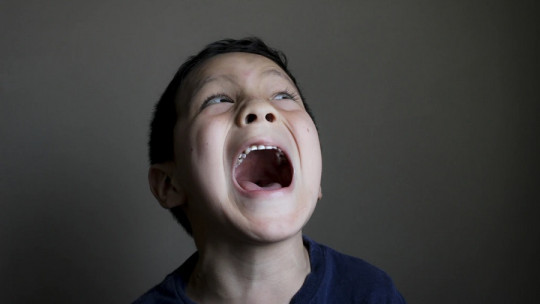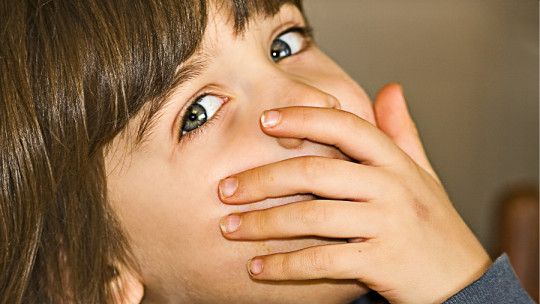
Laughing is synonymous with happiness, joy and good humor. We should all incorporate the healthy exercise of having a laugh into our lives, since it has many benefits on a mental and physical level.
However, sometimes, laughing for no reason and without it being appropriate can be an indicator that something is not right. This is known as pathological laughter, a symptom associated with psychopathology and neurological diseases which we are going to delve into below.
What is pathological laughter?
Laughter is a fundamental aspect in our lives. It is the “symptom” that reflects a state of joy, being related to very healthy effects for our mental and physical health. However, sometimes, laughter can truly be a pathological symptom, indicating that something is wrong at the brain level.
Normal laughter can be triggered by a reflex action, such as tickling. In this case, tickling causes laughter to occur through reflex mechanisms. It can also be triggered by witnessing a funny event, such as hearing a joke or seeing someone slip on a banana peel. Whether two such disparate situations can provoke the same response is still unknown.
However, as we were already saying, sometimes laughter is a sign that something is not right. Pathological laughter is considered to be laughter that appears without reason, without being proportional to the emotional stimulus that supposedly triggered it, unrestrained, uncontrolled or that appears without any apparent relationship with the stimulus.
What disorders is it related to?
As we were already commenting, laughter, in general, is a symptom of health, happiness and good humor. However, it is also a sign of some health problem, whether of a medical or psychopathological origin, appearing much more stereotyped compared to normal laughter.
There are many disorders in which pathological laughter appears as a symptom. In most of them it presents as something uncontrollable, with incontinence and emotional lability. Below we will see several groups of medical and psychological problems in which pathological laughter can be found.
1. Neurological diseases
Pathological laughter characterizes certain diseases of the central nervous system, such as tumors, multiple sclerosis, cerebral vascular diseases, dementia and traumatic brain injuries, among other nervous disorders.
1.1. Bulbar and pseudobulbar palsy
In bulbar and pseudobulbar palsy there is a unilateral or bilateral lesion of the corticobulbar motor pathways, which is related to pathological laughter. Among the medical causes behind the appearance of these paralysis we have arteriosclerosis, multiple cerebral infarction and multiple sclerosis.
In this case, laughter is characterized by its disproportion with the emotional stimulus that supposedly triggers it. In fact, it is often described as emotional incontinence and can simulate a state of emotional lability.
Among other symptoms of bulbar and pseudobulbar paralysis we have the inability to make voluntary movements, although reflex movements can be made, such as laughing, crying and sucking.
Among the brain regions affected in this neurological condition we have: the internal capsule, the substantia nigra, the cerebral peduncles and the caudal hypothalamus. In addition, there are bilateral lesions of the pyramidal tract, with involvement of extrapyramidal fibers.
1.2. Gelastic epilepsy
Gelastic epilepsy is characterized by the presence of sudden laughter attacks of paroxysmal onset, self-limited and produced by abnormal cortical discharges. This type of epilepsy was described in 1957 and its incidence is very small, 0.32%.
The attacks are more frequent during the day, and are accompanied by hypotonia and diaphoresis (excessive sweating). These episodes last about 30 seconds and are usually followed by a phase of amnesia.
Seizures are more frequent in childhood, and are usually associated with the presence of hypothalamic tumors, which is in turn associated with the appearance of precocious puberty.
This type of epilepsy can begin in the first days of life, and its most common cause is usually tumors in the hypothalamus, called hypothalamic hamartomas, and more than half of those who suffer from it have intellectual problems.
1.3. Cerebral vascular disease
A cerebral vascular disease, such as a stroke, can cause attacks of pathological laughter or crying, generally due to damage to the vertebral or basilar arteries, partially occluding them.
A special case is the so-called ictus ridenti, in which there is prolonged laughter for hours, or even weeks, followed by hemiplegia, a state of stupor or dementia. In this case, the disease is due to active destruction of brain tissue due to extensive intracerebral hemorrhage, which gradually progresses.
2. Poisoning
Pathological laughter can be caused by intoxication or substance abuse. Some Examples of substances that induce abnormal laughter are hallucinogens (cannabis and hashish), LSD, alcohol, nitrous oxide (called, in fact, “laughing gas”), inhalation of insecticides, benzodiazepines in low concentrations or application of local anesthetics. It can also be caused by an accumulation of copper in brain tissues, a symptom of Wilson’s disease.
3. Mental disorders
Pathological laughter is a symptom of several psychological disorders, and can be found in the manic phases of bipolar disorder and also associated with drug addiction, as we have seen in the previous section. However, the most common pathological laughter associated with mental disorders is that which occurs in schizophrenia.
3.1. Schizophrenia
In the case of schizophrenia, laughter appears without any emotional meaning, in the form of unprovoked or inappropriate outbursts, in the form of uncontrolled crises. Patients do not know why they are laughing, and feel that they are forced to laugh
Laughter can also appear in response to auditory hallucinations. At times, patients may quickly turn to crying. Laughter in schizophrenia has been seen as something very pathological.
3.2. Hysteria and other neuroses
Although hysteria is not currently a diagnosis in the DSM, this disorder has an extensive history, originally described by Sigmund Freud. He himself indicated that the repressed anxiety in hysteria can cause a specific affective state, which is accompanied by motor manifestations such as laughter.
In the case of hysteria, the appearance of pathological laughter has been associated with a low socioeconomic level, anxiety, feelings of guilt and loss of identity. Still, the contagious nature is not explained.
3.3. Narcolepsy
Narcolepsy manifests itself in the form of daytime hypersomnolence, causing the person to fall asleep suddenly when I should be awake. It is not known exactly what causes it, although it is known that it has a hereditary component.
The person suffers from excessive daytime sleepiness, hypnagogic hallucinations, cataplexy, insomnia and sleep paralysis.
The laughter caused by this disorder is the trigger for cataplegic attacks, which consist of a sudden loss of muscle tone without a decrease in the level of consciousness, at a time when the patient is fully awake.
4. Pediatric disorders and diseases
There are several mental disorders and diseases that have their origin in childhood in which pathological laughter can be identified:
4.1. Angelman syndrome
Angelman syndrome was described in 1965 and is also called “happy puppet” syndrome (“happy puppet”). It is a multiple malformation syndrome, which affects patients of both sexes and different races.
At the genetic level it is similar to Prader Willi syndrome, although here the causes at the genetic level can be established in four types: maternal deletion (15q11-q13), paternal uniparental disomy, imprinting defects and mutations in the UBE3A gene.
The main symptoms present in this syndrome are: severe mental retardation, especially in the area of language, frequent laughter and happy appearance This laughter is a characteristic feature of the syndrome, accompanied by a Machiavellianly happy appearance. Furthermore, they rarely cry, or even never do so.
As for somatic symptoms, we can find microbrachycephaly, prognathism, tongue protrusion, dental malposition, occipital flattening, uncoordinated body movements, ataxia, seizures and visual atrophy.
4.2. Autism spectrum disorders (ASD)
Autism Spectrum Disorders is the diagnostic label that has been used to encompass, as an umbrella, several developmental disorders that until before the DSM-5 were considered separate but related entities, such as classic autism and Asperger syndrome
Among the symptoms that occur in ASD we have: difficulties relating and playing with other children, behaving as if they were deaf, great resistance to any learning, not being afraid of real dangers, resistance to changes in routine, indicating needs through gestures, pathological laughter and not showing affection among other symptoms.
ASD usually occurs before the age of three and it is quite likely that there will be some type of intellectual problem, with Asperger’s syndrome being an exception.
4.3. Rett syndrome
Rett syndrome is a problem that has intellectual deficiency So far it has only been described in girls and has been related to a mutation of the gene that encodes the transcription factor MeCP2, which can be verified in 95% of cases.
People diagnosed with this syndrome present autistic behavior and inability to walk, growth retardation, eye disorders and stereotyped hand movements, among other signs and symptoms. They present sudden laughter at night in more than 80% of cases.
Final reflection
Although laughter is something that should be present in our lives, due to its therapeutic value and because it is the materialization of happiness and joy, sometimes it is a sign that we suffer from a problem. If we know someone, family member or friend, who has sudden fits of laughter without knowing why, It may be an indicator that you have a medical illness or psychological disorder and that needs to be evaluated and treated.
The best way to prevent a pathological situation from getting worse is to identify it in time, and pathological laughter can be a symptom that warns us that the time to act has arrived.








